As My Consciousness Fades I Feel It Seep in Again
Life — after life: Does consciousness go along after our brain dies?
How can people brought back from death after cardiac abort report having experienced lucid and bright memories and recollections without a functioning brain? The study of near-expiry experiences is challenging the idea our consciousness fades to black when our body expires

He could see a nurse and doctor, a baldheaded, "chunky fella" dressed in blue hospital scrubs. He watched as they frantically worked on his body, which was remarkable, considering he was, substantially, dead.
The man had suffered a cardiac arrest. Ordinarily in that location is no measurable, meaningful brain activeness later the heart stops chirapsia. Within two to 20 seconds the brain "flatlines."
But the man would later on tell researchers that he could encounter an unfamiliar adult female beckoning from a corner up in the ceiling. "I tin't go upwardly there," he remembered thinking to himself, so the next second, "I was up there, looking down at me."
He said he saw his blood pressure being taken, and a doctor putting something down his pharynx. He saw a nurse pumping on his chest. He accurately and vividly described the people, sounds and events of his "resurrection."

Dr. Sam Parnia estimates the human being experienced conscious awareness for three to five minutes in the absence of detectable brain activity, a time, he has said, "when no human experience should exist happening whatsoever."
The example was part of a widely reported study Parnia published in 2014 chosen AWARE — the sensation during resuscitation trial, the world's largest study of what happens to the human listen and consciousness in the early catamenia of death.
Parnia, at present a critical care and resuscitation specialist at New York'southward NYU Langone Medical Eye, believes human consciousness may continue subsequently our heart stops beating for some undetermined flow of time.
Show from AWARE and other studies, he says, raises the possibility that the listen or consciousness — the psyche, the "self," the thing that "makes me Sam" and that makes us uniquely who we are — may not originate in the brain and may be a separate, undiscovered scientific entity, like in nature to the electromagnetic waves that tin can carry sound and pictures. Mod science simply lacks the tools to show it. When we die, that entity we call consciousness or the cocky doesn't necessarily go "immediately annihilated," Parnia believes.
Parnia isn't a religious man. He insists he isn't later proof of the existence of an afterlife, or a supernatural hereafter. Rather, he and others are trying to find better ways to save the brain and avoid horrific "disorders of consciousness" similar Terri Schiavo, the Florida adult female who entered a permanent vegetative state later on her brain was starved of oxygen afterward a cardiac arrest. But Parnia is besides out to test the accuracy of seemingly fantastical claims of near-death experiencers using an objective, scientific approach.
He'due south now conducting Enlightened II, and would welcome Canadian collaborators.
I was upwards in that location, looking down at me
His goal is to study 1,500 people in cardiac arrest. When a "code" is called, participating researchers will be alerted and dispatched to resuscitation rooms carrying backpacks consisting of portable brain oxygen monitoring devices. The programme is to measure out, second by second, the oxygen levels inside the brain. At that place will also be a portable EEG to measure whether the encephalon is operation. As well, patients will be fitted with wireless headphones, through which random words and sounds (which demand to remain secret until the written report is over) will be transmitted via a tablet. Images volition besides be beamed upwards as people undergo CPR. Parnia doesn't expect anyone to open their optics. No one ever does in cardiac arrest.
"Nosotros tin then look at survivors and come across if they can think any of these stimuli, and when they were able to receive information, and how that relates to their brain resuscitation quality," Parnia announced at a recent coming together of the European Resuscitation Quango.
Ultimately the goal is to try to better understand how to bring back a whole person, not a husk of i, with an intact brain and mind, past developing a kind of gold standard brain oxygen level that doctors should target during cardiac arrest and CPR in order to optimize survival without brain damage.
But a tidy flip side, Parnia says, is that "nosotros can also study what happens to human mind and consciousness subsequently people go beyond the threshold of death."
In other words, how does the mind relate to the brain? "Can consciousness or the self continue to piece of work and exist when we dice?"
—
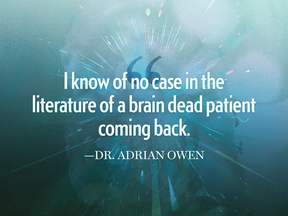
Throughout millennia people have tried bizarre means to revive the dead. In the early ages, around 500 Advertizement, people realized lifeless bodies are also common cold bodies, as Parnia has described in his talks, so they covered the newly expressionless in warm ashes or burning animal feces, assertive estrus would restore life. Later came the flagellation method, the idea that the deceased could somehow exist whipped into breathing once more. In 16thcentury Europe, rescuers used fireplace bellows to try to push air into the lungs of corpses.
In the 1900s and early on 20thursdaycentury, and through the Second World War, nosotros learned how to do mouth-to-mouth and breast compressions, "and everything inverse," Parnia said in an interview.
Today, advances in resuscitation medicine mean we can reverse death in people who have been without a pulse for hours. London Free Printing journalist Jane Simms final yr chronicled the story of Ashlyn Krell who died only was brought back to life after her automobile flipped on Canada'south busiest highway, trapping her in a construction pigsty filled with water ice-common cold water for 27 minutes.
More than people are being successfully revived after "crashing" in a hospital, and Parnia believes fifty-fifty more than lives could be saved, more people hauled back across that threshold of death, if more hospitals implemented more than advanced techniques — chilling bodies to protect the encephalon, or using automatic mechanical devices to deliver chest compressions beyond what any human could do.
For no affair why we dice, Parnia has said — a severe infection, ridden with cancer, "hit by a lorry and haemorrhaging" — most ultimately die of cardiac abort. Blood pressure drops, the center isn't able to pump enough claret to supply the body, the middle eventually stops, respiration stops, electrical activity in the brain ceases and the brain flatlines. Polish a calorie-free on the pupils and if they're stock-still and dilated, it means the brain stem has stopped functioning.
Parnia attended cardiac arrests when he was in medical school 23 years ago. Usually he didn't know the people; they weren't patients of his. By the time he arrived, they were essentially corpses. But towards the end of his preparation, he met a patient — "a sweet, lovely human" who unexpectedly went into a cardiac abort 30 minutes after Parnia interviewed him. "It was very different and at present I had personal bond with this human beingness and he was essentially a lifeless, emotionless trunk," Parnia said.
He remembers seeing him going into a apartment-line land, and people frantically trying for an hour to resuscitate the human being. He remembers thinking to himself, "What happened to this person's listen and consciousness, this sweetness human being existence that I was talking to just a half an 60 minutes ago? Is he conscious? Is he able to come across us, hear united states? When did he lose it, if he did lose his consciousness?" To Parnia, information technology was all very blurred.
As he stood and watched, he thought: what's been done on this, scientifically?
—
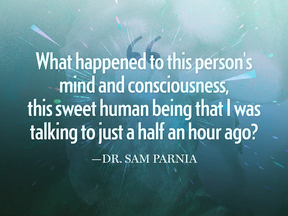
"Transcendental mystical or spiritual experiences close to expiry have been described for millennia," Parnia wrote in 2017 in QJM: An International Journal of Medicine. Plato'southward Commonwealth told the story of the Greek warrior Er, who died in battle simply was brought back and tells a tale of the afterlife. Dutch painter Hieronymus Bosch's 15thcentury painting "Rise of the Blest" depicts a tunnel of light, with souls ascending into a heavenly place. Only it was after the birth of modern intensive care medicine twoscore years ago that the term "nearly-death experience" came to existence. Philosopher and psychiatrist Raymond Moody, whose 1975 book, "Life Subsequently Life," detailed the experiences of more than 100 in one case dead — people who experienced "clinical" death simply were revived — coined it. The book sold more than than thirteen million copies.
The stories of "experiencers" share strikingly like features: a sensation of feeling peaceful and joyous and an absence of pain; a warm, welcoming lite that draws people, sometimes through a tunnel; being greeted by apparitions of deceased relatives, or a "being of light," a panoramic review of key moments of one's life.
The most widely used tool to quantify near-expiry experiences is called the Greyson NDE Scale. Published in 1983 by American psychiatrist Bruce Greyson, the scale is based on his interviews with 74 people, and scores responses to 16 questions, such equally, "Did y'all encounter, or experience surrounded by, a brilliant calorie-free?" "Did y'all seem to enter another unearthly world?" A score of seven or college qualifies the experience as an NDE.
Studies accept found that six to 23 per cent of cardiac-arrest survivors written report lucid memories that fit with a near-death feel.
Parnia dislikes the term. He prefers "actual decease feel," and says NDE's, for the sake of standardized scientific research, should be limited to those that represent to an actual physiological land that approximates death.
And nothing comes as shut to understanding the bodily experience of decease as cardiac arrest.
—
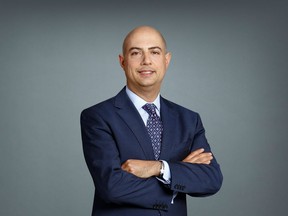
Parnia was taught in medical school that consciousness is undeniably a by-product of the brain, "that it's probably some sort of epiphenomenon that arises from synaptic activity," meaning the advice between neurons. Numerous studies show a correlation between the activity of the mind and changes in the encephalon. Slide someone inside a functional MRI and ask him or her to retrieve most something happy or pitiful. Synaptic changes in oxygen or glucose levels in detail parts of the encephalon lite upwards. "The problem with all those studies are that none of them are causative — none of them evidence you how brain cells could possibly generate a thought, which is the fundamental trouble of consciousness," Parnia says.
"If you look down a microscope at a encephalon cell, and I said to yous, this brain cell is at present thinking, you'd say that's crazy, information technology'south a brain prison cell." Encephalon cells produce proteins that generate changes in sodium, which generates electricity. "That'south non a thought," Parnia says.
"And if I said, well, somehow, if I connect a hundred or a thousand or a million of these cells together, it just leads to this magical miracle of thought. There'south no mechanism to account for why that should occur. Why would my brain cells, millions of them connected together, all of a sudden feel guilty, or have a sentiment of guilt, like if I were to throw a brick in my neighbour's window, or exist rude to somebody or do something immoral?"
The moment the heart stops, the brain shuts down from a functional perspective, he said. "However, paradoxically, what we started to see is that millions of people have now been resuscitated, and many of them take reported these very lucid, well-structured thought processes." They're able to form memories, describe conversations and what people were wearing. "Except that their brain has shut downwards and they've gone through expiry. Which is completely a paradox, it should not happen. If your mind is simply a by-product of your encephalon, if your brain has shut down, at that place should be no consciousness."
Yet, paradoxically, what we started to run into is that millions of people have now been resuscitated, and many of them take reported these very lucid, well-structured thought processes
The phenomenon has been described worldwide, from Japan, Republic of india, the Middle East and the Americas. They're remarkably consistent across cultures and religions, and have been reported by children every bit young equally preschoolers. Parnia once interviewed a iii-year-former boy who survived a cardiac arrest after an epileptic seizure. "When I died, I saw a bright lamp," the boy told Parnia during a play session. "Grandma came to meet me and said I was going to be okay." Other children have described the "being of low-cal" not as God, or Jesus, but Santa Claus. Toddlers aren't exposed to religious doctrine, says Dr. Elaine Drysdale, a clinical professor in the department of psychiatry at the Academy of British Columbia. Yet they written report near-death experiences similar to older children and adults.
Parnia'south detractors accept defendant him of "dog whistling to theists." The notion of a soul or mind existing dissever from the trunk is scientific flapdoodle, they say. Renowned Western University neuroscientist Adrian Owen, who has devoted much of his career searching for signs of consciousness in "vegetative" patients, says the encephalon is the organ that produces consciousness, full stop. "If y'all take that organ abroad or kill that organ or that organ dies, y'all cannot exist witting." While there is no identified conscious centre of the brain — nothing you can point to and say, 'there, that'south where it all happens" — Owen was part of an international squad that recently identified two especially distinct patterns of complex brain activeness that tin differentiate a conscious brain from an unconscious 1.
He doesn't believe patients who written report well-nigh-decease experiences get to a state where there's no detectable brain response whatever. If that were true they would be classified as encephalon dead, "and I know of no instance in the literature of a brain dead patient coming back." Owen's not proverb they're not nigh dead. But the brain has an amazing vasculature. Unless a person dies of massive trauma that knocks out all brain function immediately, like going through the windshield of a car, parts of the brain will continue to get oxygen for some time after the middle stops, Owen says.
Memories or sensations of a seemingly disembodied consciousness could too be happening earlier the encephalon shuts down, or later middle and brain function starting time coming dorsum online. NDE denier and Australian anesthesiologist G. M. Woerlee has argued compressions during CPR itself can push button claret around the body and through the brain in sufficient plenty amounts to sustain some form of consciousness, and that these people "are well-nigh definitely not 'flatlined.' "
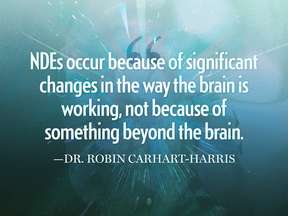
In fact, McGill University doctors reported terminal yr the case of a 38-year-old human who appeared to regain consciousness several times during CPR. The man was defibrillated six times. Throughout the ordeal he made "purposeful movements to push CPR providers abroad" and verbalized with each jolt of the defibrillator, Dr. Roger Grey reported in the journal Canadian Family unit Dr.. When signs of consciousness were recognized, CPR was immediately halted, and his pulse checked. There was no palpable pulse. Restraints were practical, CPR resumed and his heart resumed beating once again 17 minutes after he initially went into cardiac abort.
When interviewed three months afterward, he recalled experiencing discomfort in his chest and neck, but no pain. Although he made a complete recovery, the situation was distressing for his resuscitators. None "had e'er experienced a patient regaining consciousness with CPR, nor were they enlightened that it was possible."
Jimo Borjigin is an associate professor at the University of Michigan Medical Schoolhouse. In experiments in rats, Borjigin and her colleagues discovered that the rodents experienced a huge surge in the secretion of brain chemicals inside the get-go xxx seconds later the heart stops. Their dying brains seemed to become highly aroused. "Serotonin in item was very loftier," she says. "Nosotros know that the serotonin is associated with hallucinations and other mental functions."
Aye, the overall level of electrical activity of the brain was lower, Borjigin says. "Merely the part that is at to the lowest degree partly responsible for witting data processing is actually increased tremendously in the dying encephalon," she says— for 30 seconds at least.
More than astonishing, researchers at Western University reported ii years ago the case of a patient who was taken off life back up who continued to prove bursts of brain wave activity for upwardly to 10 minutes afterwards the concluding heartbeat.
The authors don't know how to explain the postal service-mortem delta wave bursts. It was also a sample size of one. Parnia, for his part, doubts the brain activity recorded in the otherwise dead rats would exist adequate to produce the kind of lucid and vivid memories reported by humans who merits to have gone through a most-death experience.
He likewise has trouble with the hallucination theory. When people have a lack of oxygen to the brain — something Parnia sees daily in the intensive care unit —they get completely delusional and disoriented. With delusions, thinking becomes fragment, a muddled mess. "They don't have well-structured thought processes," he says. They thrash about and, if the oxygen becomes too depression, they get into a coma. NDE-ers, by contrast, report bright experiences.
In add-on, "people are coming dorsum and describing real events that accept occurred and that doctors and nurses have verified, validated." So, past definition, they can't be hallucinations, because they're describing real events, he argues.
This isn't the "locked-in" syndrome, where people are conscious and can think and reason but unable to speak or motility. Or people in a "vegetative" country because of a severe brain injury. People who report about-death experiences describe their consciousness separating out, withdrawing from their bodies. Says Parnia: "They're watching it, they can see it happening to them, but they're non in hurting and they're wondering why everyone is worrying virtually them. 'I don't understand why they think I'm dead because I don't experience dead, although I don't know what I'k doing up here in the corner of the room.'"
The original Enlightened trial involved ii,060 cardiac arrests beyond 15 hospitals in the U.S., the U.K. and Austria. Of those, 330 people survived. Nine who were able to undergo detailed interviews had experiences compatible with a near-death experience, Parnia and his co-authors reported in the journal, Resuscitation. Ii reported an out-of-body experience; including the man who reported "seeing" and "hearing" things as he hovered near the ceiling over his lifeless torso.
But there's a hitch: To examination the veracity of out-of-body experiences, or OBEs, researchers had stacked shelves in rooms where people were most likely to become into cardiac arrest, similar coronary intendance units, the ICU and emergency wards. Atop each stack of shelves, visible only from the ceiling looking down, were hidden targets – pictures of a baby, a pinkish dog, a newspaper headline of Princess Diana'south death. The researchers were after visually "veridical" OBEs, in which the experiencer reports verifiable information that could never accept been obtained past any earthly means. Skeptics have argued that it's entirely possible people see or hear things while the brain's sensory pathways are shutting down. But what if they could get verifiable proof of "remote viewing?"
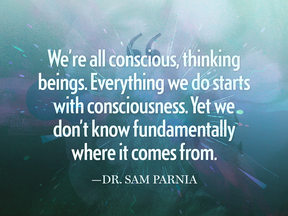
However, most of the cardiac arrests took place in areas without the shelves. None of the nine who reported NDEs — and neither of the two who reported out-of-body experiences — reported seeing the hidden images.
Even fleeting bursts of electrical activity deep in the brain'south temporal lobe, fifty-fifty a few seconds worth, tin can evoke experiences of the paranormal and mystical. Last August, a team from Imperial College London reported that the psychedelic drug DMT mimics near-death experiences in the brain. Thirteen volunteers given intravenous DMT completed the Greyson calibration — that standardized questionnaire that tries to quantify near-decease experiences. They all scored above the threshold for an NDE. Dr. Robin Carhart-Harris, the study'due south supervisor, noted when the paper was released: "These findings are of import as they remind united states of america that NDEs occur considering of significant changes in the way the brain is working, not because of something beyond the brain."
Parnia allows that information technology'southward entirely possible people who study conscious experiences during cardiac arrest also had higher blood and oxygen menstruation to their brains. Only that doesn't brand the experiences illusory or unreal, he says. Studies accept found that NDE memories are richer in item — they seem more real — than memories of real life events. To Drysdale, of the U of BC, that suggests "that as the encephalon is shutting down, our consciousness actually increases."
Simply when is the brain, actually, dead?
"The precise bespeak beyond which the brain is no longer 'living,' a threshold which remains unidentified, is perhaps less definite than has been historically assumed," Laurentian University researchers wrote in PLOS One in 2016. Death is a process, Parnia says, not an absolute, blackness-and-white moment. "It's really just after a person has died that the cells start to undergo their ain process of death, and that can take hours."
Even when the brain flat lines — no sign of encephalon waves on a standard EEG — brain cells don't die immediately, Parnia says. It may take hours before they go permanently damaged.
In 2012, researchers at the Pasteur Institute of Paris discovered stem cells could remain alive in homo corpses for at least 17 days later on death (the cadavers were stored in a mortuary at iv degrees Celsius to keep the bodies from decomposing.) A Baltimore team has been able to generate living stem cells from the scalps and brain linings of people who had been dead for up to 21 hours. The Laurentian squad was able to elicit living-like, electrophysiological responses in post-mortem human brains when they exposed the expressionless brain tissue to chemical and electrical probes. "When the brain is dead and the tissue has lost its structural integrity, the individual is causeless to no longer be represented inside what remains of the organ," the researchers wrote in PLoS One. "Together, these results propose that portions of the post-mortem human being encephalon may retain latent capacities to respond with potential life-like and virtual backdrop."
That's certainly what the people putting upwards United states$10,000 to have their brains cryogenically frozen or "vitrified" are banking on. One Silicon Valley start upwards claims to be developing technology that tin preserve not just the physical brain, just too the memories within it, with the goal to one twenty-four hours upload those frozen memories into a server so people tin can live a new life equally a calculator simulation, maybe a robot.
Only absent vitrification, and certainly without any life back up, the brain eventually degrades. Death after cardiac abort is reversible — up to a point. And there's still no verifiable evidence that annihilation like consciousness leaves the dying torso.
"For materialists, we are each our brain and we die with information technology," Gregory One thousand. Nixon wrote in the Periodical of Consciousness Exploration and Research. Francis Crick, co-discoverer of DNA said consciousness was an epiphenomenon, a by-production of synaptic activity in the brain. However, there were Nobel winners in both camps: Sir John Eccles, who won in 1963 for his piece of work on the synapse, dismissed the listen-brain theory, arguing, "The homo mystery is incredibly demeaned" by such scientific reductionism. The field remains similarly divided today.

Parnia says he's keeping an open mind. He cringes at recent headlines challenge, "When you die you lot actually KNOW you're expressionless because your brain still works for a while." The whole idea is seriously unsettling, and, Parnia noted in a recent interview with Newsweek, the thought "petrifies people." For some, it also raises a creepy corollary: could we spotter our organs being retrieved while floating, disembodied, most the ceiling?
If nothing else, Parnia says that people who come back from clinical expiry — accepting that theywere technically expressionless —who study having seen vivid lights or inbound a supernatural realm often become wholly transformed past the experience. They become more than altruistic, less self-centred, more engaged with helping others. Less afraid of death. "They view the globe in a different fashion," Parnia says.
Still, most-expiry experiences aren't all cosmic lite and luminous, loving beings. Some, equally Bruce Greyson and Nancy Evans Bush wrote in the periodical Psychiatry in 1992, are "bluntly hellish." Some people have described existence sucked into voids, or seeing grotesque beings wailing and moaning. "There are people who tried to commit suicide whose experiences take been very, very unpleasant and problematic for them," Parnia says.
He was young and naïve when he kickoff embarked on the mind-body question 20 years ago. "I thought to myself, nosotros can probably figure this out in, like, a twelvemonth, twelvemonth-and-a-half of research," he says.
"Nosotros're all conscious, thinking beings. Everything we do starts with consciousness. Still we don't know fundamentally where it comes from."
National Mail service
• Email: skirkey@postmedia.com | Twitter: sharon_kirkey
Source: https://nationalpost.com/news/canada/life-after-life-does-consciousness-continue-after-our-brain-dies

Post a Comment for "As My Consciousness Fades I Feel It Seep in Again"